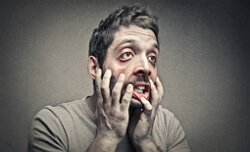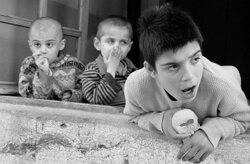Reactive psychosis
 Reactive psychosis is a reaction of a psychotic type that occurs as a response to the unhealthy level of psycho-trauma or negative life aspects that provoke fear, anxiety, anger, anguish or other emotional negativity. This is a kind of disadaptation of mental work with a reversible character. Each person does not have the opportunity to be safe from this situation, because the protective system of the psyche is personal, and there is no reliable knowledge of what a stress level will lead to the complexities of mental work and will give symptoms of reactive psychosis. If in time, at the initial moments, to detect a problem, in this outcome there is an opportunity to help a person absolutely and forever forget about such a psychiatric problem.
Reactive psychosis is a reaction of a psychotic type that occurs as a response to the unhealthy level of psycho-trauma or negative life aspects that provoke fear, anxiety, anger, anguish or other emotional negativity. This is a kind of disadaptation of mental work with a reversible character. Each person does not have the opportunity to be safe from this situation, because the protective system of the psyche is personal, and there is no reliable knowledge of what a stress level will lead to the complexities of mental work and will give symptoms of reactive psychosis. If in time, at the initial moments, to detect a problem, in this outcome there is an opportunity to help a person absolutely and forever forget about such a psychiatric problem.
Reactive psychosis - what is it?
Reactive psychoses for ICD-10 belong to the chapter under number F43.This type of disorder is relatively short-lived and provoked if there is an obvious psychotrauma. This type of disorder unites the presence of a stress factor. The importance of stressors is ambiguous, there are possible any reasons, like physical, climate change, atmospheric features, and chemicals, biological diseases, psychological - sorrows, offense. In an ordinary environment, the body gets used to stressors, because this is a universal mechanism of interaction between the organism and the environment. Pathogenic they are considered in the case of increased strength, the acquisition of negative modality, can cause cognitive and emotional impact on the psyche. If the adaptive possibilities are exaggerated, then the body reacts not only mentally, but psychosomatics appears. But all violations have the possibility of reversibility, if you stop the exogenous-stress agent.
Forms of reactive psychoses: shock affective reactions that occur at short notice, reactive depression and paranoid, and hysterical psychoses are very common.
Affective shock reactions manifest themselves at risk for existence, consciousness is darkened. After this event, the memory is erased.
Reactive stupor is a numbness that occurs suddenly. The person is immobilized, but reacts to the memory of a psychotrauma. This condition passes through sleep and amnesia. In rare cases, there is emotional paralysis, accompanied by indifference.
Prolonged reactive psychosis, having the character of psychogenic, manifests itself in the form of a depressed reaction character and paranoid.
Depression of a reactive nature is a depressive reaction provoked by severe events, loss of people, more often close ones. Sometimes it's even a depressive stupor.
The reactive delusional psychosis is, according to modern terminology, delusional paranoid. The reaction to the stressor manifests itself in a psychotic manner and pushes to the formation of delusional thoughts. Sometimes even auditory hallucinations may occur with a similarly delusional composition. The reactive delusional psychosis has atypical forms: quirulent delirium, or litigation. Such people roll complaints, go to any instance, sometimes for ridiculous reasons. In individuals with a decrease in hearing, there is a delirium of persecution of the deeper. Sometimes it happens in a foreign environment, when a person does not understand the language.
The reaction to an acute stressor occurs with an unusual emotional-stress factor. Post-traumatic stress disorder is now very relevant in the field of psychiatry. It arises as a severe reaction to the experienced strong psychotrauma.
Hysterical psychoses have subspecies:
- Twilight confusion is a consciousness known as Ganzer's syndrome.
- Similar to dementia, pseudodegmentia Wernicke.
- Specially children's foolish habits, in the form of puerelism and wild syndrome, in which the person amnesizes the rules of decency.
Reactive psychosis: causes of
The main etiology of reactive psychosis is psychogenic. Any mental trauma, grief, break, divorce, death of loved ones, loss of work, bankruptcy are possible. Also, an overpowering emotional shock causes a similar symptomatology, for example, in the eyes of a person, an accident, anthropogenic disaster, a natural disaster occurred.
There are many mechanisms leading to the emergence of reactive psychosis. Such disorders are always displayed on the affective state of a person, that is, the mood will change first. There is always a connection with the stressor. This is a disease in which external factors play the most important role. The name itself highlights the importance of the body's response. It is for this reason, in the most favorable outcomes, that reactive psychosis is limited to a short period of time. If this is provoked by an acute factor, that is, a state of shock, the condition lasts a couple of hours, a maximum of 6 days. If the form of reactive psychosis is delayed due to long-acting factors, then the duration is from one week to 30 days. And the reaction in such cases is already more structured, by type of depression, hysterical psychosis or paranoid. It is at the first appearance with more short-term course that the patient urgently needs help from a doctor.
Reactive psychosis manifests itself immediately after the provoking factor, but there are times when it takes a little time after the stressor. It is characteristic that eliminating the cause, the phenomenon passes by itself. Their main difference from the neurotic spectrum diseases is the duration and severity of the symptoms, as well as the possibility of obscuring the mind.
The main aspects of the manifestation of reactive psychosis are characteristics of psychotrauma, external provoking factor, individuals are at risk for this type of disease. Thus, even an enclosed space, such as being in prison, can provoke a reactive psychosis. To this same characteristic belong railway paranoids.
In the case of predisposition of the person to such diseases and the presence of a stressful phenomenon that produces a strong effect on the personality of the patient, the functionality of the nervous system decreases. Over time, the person is mentally asthenicized, leading himself to the psychic, and often even to physical exhaustion. Often an important factor is the constitutional predisposition. A negative role can be played by panic, especially in the case of mass disasters, and irreplaceable losses negate these phenomena.
If you determine the reasons, then the most common are conflicts, in the meaning of public problems, any mass or personal turmoil. A very deplorable role can be played out by pathogenic processes, intoxication, crisis age, brain trauma.
Important personality risk factors, which are more likely to be affected by the above reasons, are the young people under 33, due to their expressive social activities. The more they face negative factors, the greater the risk that one of them will negatively impact them. Emotionally unstable persons, or having a history of dependence, are also more likely to fall under the influence of negativity. Dangerous life periods: menopause and puberty, severe somatic diseases also are among the risk factors for the development of this condition.
Reactive psychosis: symptoms of
Forms of reactive psychoses differ in their symptoms. Prolonged reactive psychosis always lasts 30 days or more, complicating the life of the patient.
Reactive depression can cause the death of a loved one, difficult life situations. The person is depressed, his face is sad. They walk slowly, they sit for a long time in a monotonous position. Often take the position of the embryo. They talk reluctantly, often, if they answer, little. Experiences, in the main mass, are localized around the experience, they persistently sit in the head. These thoughts sometimes become overvalued, and sometimes turn into nonsense. Retardation sometimes reaches a depressive stupor. If anxiety, fear or anger is added to longing, psychomotor agitation develops. Persons crying, wringing their hands, injuring themselves or even trying to kill themselves.
Reactive paranoid is manifested by delusional syndrome. Can show itself in different delusions. Some think that they are being persecuted or co-influenced, others think about relationships. Most often, nonsense depicts a psychotrauma. Everything around is interpreted as nonsense and has a special meaning. Sometimes hallucinations repeat the meaning of delirium. The behavior of these persons is determined by delirium. In atypical forms of delirium, litigiousness arises. We can meet such people complaining in different instances. These individuals are dangerous to others, pushed by their delirium.
Post-traumatic stress disorder has its own diagnostic criteria: the existence of a stressor of catastrophic level, obsessive memories in the form of reminiscences about a traumatic event, sometimes flashbacks appear in the form of traumatic dreams. Affected individuals try to avoid stressful circumstances. They are alienated, cease to be socially active, there are sharp flashes of panic, fear and aggression. All this starts from 2 to 6 months after the trauma from vegetative disorders, although no changes are detected in paraclinical studies.
Adaptation disorders occur within 30 days after the stressor, the symptomatology is directly related to the stressor, lasts more than 6 months.
With particularly severe shocks, especially with a life threat, hysterical psychoses can occur. They have several successive episodes. First is Ganser's syndrome, which responds to the twilight twilight. The patient is disoriented in external data, while demonstrative, the behavior of the parade. The whole speech is out of place, facial expressions are absurd. Further, the phase of puerilism, in which a man behaves childishly, but has adult habits. And the last phase is called pseudodementia. This is a false dementia that looks like a loss of knowledge. People are able to improperly dress, but are completely oriented. There may be a hysterical stupor, in which a person is inhibited, silent and starving.
Acute reactive psychosis
Acute reactive psychosis has several subspecies.
• Hypokinetic subtype of reactive psychosis, or reactive stupor, not differing from other forms of this manifestation, is accompanied by instantaneous numbness, mutism. A person does not have the ability to take a step, conversation in this pathological state is not possible. The duration does not exceed a couple of hours, while the muscle tension is expressed. The patient lies. Facial expressions of despair or fright. If he talks about a trauma, he changes in the face, becomes covered with sweat. After that, he will fall asleep and forget everything. In certain cases, the state does not reach stupor, the personality contacts formally enough, the answers give slowly, stretching words. Movements are constrained, slowed down. Consciousness is narrowed or stunned. Less often this condition leads to emotional paralysis in the form of long-lasting apathy with a parallel attitude to the previously threatening situation and the surrounding society.
• The hyperkinetic form of reactive psychosis is characterized by reactive excitation. Instantly, the man chaotically, unmotivated moves, rushes, shouts, hears for help. Consciousness is overshadowed, orientation is broken with advancing amnesia. A person can even run towards danger without realizing it.
• Acute response to a stressor is also attributed to similar species. Important for this diagnosis will be: the presence of a previously unusual stressor, a sharp start after the event, with the consciousness deafened, attention reduced, anxiety, anger, despair, spontaneity, excessive grief, vegetation, oblivion of the episode and rapid release after the cessation of stress. In paraclinical studies, changes are not detected.
• Hysterical psychosis also develops as acute in certain cases. This includes the savagery syndrome, when a person grabs food by hand, behaves like an animal. They can climb, resembling animals, roar, bark, sniff food. At the same time, individuals are not capable of self-service, they can be aggressive. Perhaps the emergence of dementia, by the type of mimicking, puerilism, hysterical twilight.
• Infectogenic or catamate amnesia is a type of memory disorder that only affects negatively colored events. When a person is asked about neutral events, he remembers everything and his answers are correct. This type of memory impairment is characteristic of hysteroid individuals. It appears after twilight and is based on the phenomenon of hysteroid displacement. To correctly determine this condition, it is important to find out the association of events in time, the symptoms of psychosis show directly the events of the event, the chances of getting out of the disastrous state after the stressor ceases.
Reactive psychosis: treatment with
With reactive psychosis, the regimen plays a decisive role. It is important to live in a normal day, to sleep enough, to eat during the day three times or more. Vitamins favorably affect anxiety, so you should eat greens, pumpkin dishes and carrots with oil to saturate the body with vitamins A and E. Vegetables and berries are indicated for replenishing vitamin C. Vitamins for the nervous system are group B, which are found in cereals, Yoghurt, bread with bran and meat. Important and trace elements, Magnesium, reducing stress levels, in greens, buckwheat, legumes, also calcium, zinc, glucose and choline. Folic acid, which helps in the synthesis of dopamine, in the liver and broccoli. Omega 3 polyunsaturated fatty acids have an excellent effect.
Physical activity contributes to improving the course of reactive psychosis and helps to overcome stress.
Pharmacotherapy .Tranquilizers: benzodiazepines - Sibazon 0.5% 40-60 mg IM, Gidazepam 0,06-0,2 g orally. It is important to remember that the predominant majority of drugs from this group lead to the addictive effect. Antidepressants with sedative effect: Amitriptyline 150-300 mg / day, Ftorazicin 150-200 mg / day, Pyrazidol 150-200 mg / day, Azafen 150-200 mg / day. Oxylidine is suitable for older persons due to the hypotensive effect of 500 mg / day. In particularly severe reactive psychoses, especially with the presence of psycho products, antipsychotics are used. In general, neuroleptic sedatives are used: Aminazine 50-100 mg 2-3 r / day, up to 1200 mg, Propazin is weaker than the previous one, but less toxic. Tizercin 300 mg / day, Teralen reduces phobia 25-400 mg / day. Of the new, more sparing, Sonapax 300-600 mg / day, Neuleptil 30-50 mg / day, Chlorprotixen 200-400 mg / day, Azapine 50-200 mg / day.
At the supporting stage, normotimics and nootropics are used. Lithium salts 1800-2400 mg / day, Aminolone 300-1000 mg / day, Acephane 300-1000 mg / day, Pyriditol 0.3-0.4 g, Piracetam 20-30 g / day.
Psychotherapy is a very effective method for these conditions. Apply suggestive methods in the form of hypnotic sleep. But not all patients are hypnotic, so not everyone can be helped in this way. Psychoanalysis is effective for patients with protracted reactive psychoses, helps to pull internal conflicts out of the subconscious. Well, the analysis of dreams in resolving many conflicts helps. Behavioral-cognitive therapy contributes to the improvement of the condition with common reactive manifestations. To combat panic at the time of reactive psychosis autogenous relaxation will help. Occupational therapy, sociotherapy and art therapy can also serve as a complementary link in the management of reactive psychoses.



